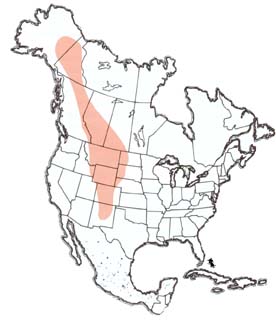Kennicott Grasshopper
|
|
|
|
Geographic range of Melanoplus kennicotti Scudder |
|
|
Distribution and
Habitat
Economic
Importance
Food Habits
Migration and
Dispersal
Identification
Hatching
Nymphal
Development
Adults and
Reproduction
Population
Ecology
Daily Activity
Selected
References
Distribution and Habitat
The Kennicott grasshopper, Melanoplus kennicotti, ranges in a wide band along the Rocky Mountains from Alaska to New Mexico. It inhabits the grasslands of mountain meadows and parklands and the western edge of the northern mixedgrass prairie. The species resides at elevations ranging from 100 feet in Alaska to 11,060 feet in the Absaroka Range in Wyoming. In Alaska the species inhabits open areas of the mixedgrass-forb-moss association at elevations of 100 to 450 feet.
Economic Importance
A feeder on forbs and grasses, the Kennicott grasshopper is a potential pest of forage in mountain parklands. It is a small species that during years of outbreaks, makes up for its size by large numbers. Adding its impact to the damage caused by other pest species during outbreaks, it contributes to the depletion of livestock and wildlife forage in parklands. Occasionally, it is the predominant species of the grasshopper assemblage, but no quantitative studies of its damage have been made. Live males weigh an average of 173 mg and live females 285 mg (dry weight males 60 mg, females 100 mg).Food Habits
The Kennicott grasshopper feeds on a variety of forbs and grasses. Observations of released adults in their natural habitat in early fall revealed that they fed upon several forbs: dandelion, a sagebrush (Artemisia tripartita), prairie chickweed (Cerastium arvense), and an unidentified forb sprout approximately 1 inch tall. The latter plant was consumed to ground level in 6 minutes. One adult was observed to feed on prairie junegrass which had greened up after late summer rains. It ate the distal 1 inch of a 2-inch-tall leaf. Field observations were limited both by time spent watching individual grasshoppers and by the short window of adult life scrutinized in fall. Observations should be made ideally from late spring to early fall so that grasshoppers may encounter all kinds and stages of plants in the habitat. This mountain study site had a rich floral diversity including a minimum of 20 forbs, 9 grasses, and 2 sedges.Confined in cubic-foot cages on transplanted sod from the study site west of Tie City, Wyoming, adults were observed to feed on dandelion, prairie chickweed, prairie junegrass, wild buckwheat (Eriogonum umbellatum), Arenaria fendleri, and Poa cusickii.
Laboratory two-choice tests showed that dandelion, alfalfa, Cryptantha thyrsiflora, and downy brome were preferred; Erigeron eatoni, Heterotheca villosi, Kochia scoparia, and Poa pratensis were rejected. Adults consumed some of Astragalus sp. but results were unclear.
Although these observations and others of feeding by the Kennicott grasshopper show that it is a polyphagous species consuming both forbs and grasses, they do not provide vital information about its diet. Such observations fail to reveal the proportions of food items ingested and the changes in diet that are sure to occur seasonally. Only a detailed study by quantitative analysis of gut contents of grasshoppers taken from several habitats at different densities and times of the season will disclose fully the Kennicott grasshopper's food habits.
Migration and Dispersal
Flushed flight of the Kennicott grasshopper is short (4 to 5 feet) and low (6 to 8 inches above the ground surface). The flight is silent and usually straight but may be circuitous. Direct evidence for voluntary flight is lacking. No migrating swarms have been seen and reported and no frozen specimens have been found on glaciers. Likewise no appetitive flying has been observed in study sites of the Laramie Range. Nevertheless, a study of population densities in the infested square mile area west of Tie City, Wyoming, provide circumstantial evidence for a slow dispersal from the center where densities were highest to the edges where densities were lowest. Less likely is the possibility that of apparently uniform parkland the central area was a more favorable habitat than all four perimeter sites.Identification
|
Figures 1-5.
Appearance of the five nymphal instars of Melanoplus kennicotti - their
sizes, structures, and color patterns. Notice progressive development of wing
pads and antennae. BL = body length, FL = hind femur length, AS = number of
antennal segments. |
 |
|
Fig. 1, First Instar:BL 4-5.9 mm FL 2.2-3.3 mm AS
12-14. |
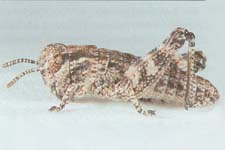 |
|
Fig. 2, Second Instar:BL 6.3-7.2 mm FL 3.5-3.6 mm AS
14-16. |
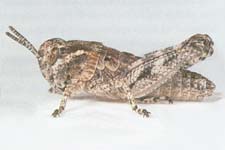 |
|
Fig. 3, Third Instar: BL 7.8-9.6 mm FL 4.4-4.9 mm AS
16-19. |
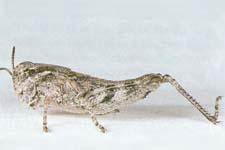 |
|
Fig. 4, Fourth Instar:BL 10.5-15.5 mm FL 6.5-7.8 mm AS
19-21. |
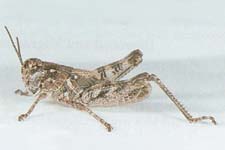 |
|
Fig. 5, Fifth Instar:BL 13.5-18 mm FL 7.7-9.1 mm AS 21-22.
|
|
Figures 6-10,
Appearance of the adult male and female of Melanoplus kennicotti, end of
male abdomen, side of head and thorax of male instar V, and eggs and
pod. |
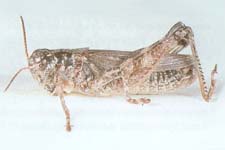 |
|
Fig. 6, Adult Male:BL
15.5-17.5mm FL9.7-10mm AS 23-24. |
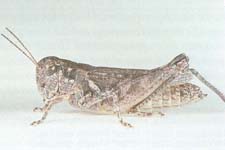 |
|
Fig. 7, Adult Female:BL 20-32 mm FL 10.5-12.3 mm AS
23-25. |
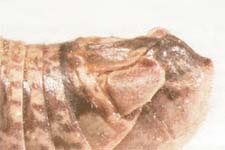 |
|
Fig. 8, End of male abdomen showing the
cercus. |
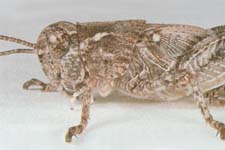 |
|
Fig. 9, Side of head and pronotallobe showing crescent,
instar V . |
 |
|
Fig. 10, Exposed eggs
and egg pod. |
The nymphs are identifiable by their color and color patterns (Fig. 1-5).
- Head tan or pale gray, each ridge of frontal costa with a row of 8-12 fuscous spots; antennal segments black with anterior annulus cream-colored; compound eye brown with tan spots, a transverse dark bar crosses center of eye, each side of dark bar with adjacent tan bar; top third of eye pale brown, bottom third dark brown.
- Crescent on side of head and pronotal lobe creamcolored or tan, crooked on lobe (Fig. 1-4 and 9), may be interrupted on lobe (Fig. 5), or entirely absent.
- Hindleg: medial area of femur with light and dark transverse bars and areas, middle dark bar shaped like feather and shaft of arrow (See Fig. 3 for clear depiction); marginal area with 2 tan and 2 black transverse bars in instar I, 3 tan and 4 black transverse bars in instars II to V; hind tibia with side black or gray in instar I, gray or tan in instars II to V, front of tibia and spines black in all instars.
- Venter of thorax and abdomen pale gray or tan, spotted brown.
- General color gray, tan, or cream with many fuscous spots, a few specimens melanistic.
Two characters useful in identifying the nymphs of the Kennicott grasshopper are the crooked crescent and the feather-and-shaft marking on the medial area of the hind femur.
Hatching
From eggs that overwinter in the soil, the Kennicott grasshopper hatches in late spring. It is one of the early hatching species in the montane environment along with Melanoplus alpinus, Bruneria brunnea, Camnula pellucida, and several others. These early species hatch about one month after snow melt exposes parkland vegetation. In the mountain study site west of Tie City, Wyoming (Laramie Range T15N, R72W, Sec 15 NW, elevation 8,600 feet), the Kennicott grasshopper along with M. alpinus and B. brunnea began to hatch 6 June 1994 and 24 June 1995. In the same site, the hatching of M. infantilis and M. sanguinipes did not begin until 5 July 1994 and 5 August 1995. This would place these two species in the intermediate hatching group of montane species. However, at lower elevations as in the grasslands of the High Plains, they belong to the early hatching group. The length of time that the hatching eggs of the Kennicott grasshopper have lain in the soil is unknown. The eggs may have been laid the previous summer or two or more summers earlier.
Nymphal Development
The nymphs develop early in summer when montane weather is variable but vegetation is green and nutritious. A few days of cold rain or snow may occur but most days are sunny and warm. The length of the nymphal development, as measured from first hatch to first adult, is short. In the parkland west of Tie City, Wyoming, this period was calculated to be 29 days in 1994 and 38 days in 1995. The length of the latter figure may be an over estimate due to difficulties in netting the first adults.
Adults and Reproduction
In mountain habitats the adult stage of the Kennicott grasshopper is reached in early summer. In the parkland west of Tie City, Wyoming, adults appeared 2 July 1994 and 29 July 1995. For comparison, adults of M. infantilis appeared 7 August 1994 and 29 August 1995. Survival of adults of the Kennicott grasshopper was high through August and the first half of September, but declined noticeably by late September. A small number of hardy adults survived into October. Sampling of the population in 1995 showed that in 200 semicircular sweeps of a 15-inch diameter insect net, an average of 3 adults were captured in August but by 18 September only one adult was captured.Females caged with males oviposited into containers of bare soil. Pods were curved and 3/4 to 1 inch long. Three pods contained 12 eggs each. Eggs were pale tan and 4.2 to 4.6 mm long (Fig. 10).
Population Ecology
The Kennicott grasshopper maintains a low frequency of occupation of mountain meadows and parklands in Wyoming, as indicated by results of the Wyoming Grasshopper Survey. From 1991 to 1994, 256 sites in the Rocky Mountains were investigated. In only 35 sites was the Kennicott grasshopper collected (14 percent frequency). For comparison, the alpine grasshopper, M. alpinus, occupied 83 of the 256 sites (32 percent frequency) and the Bruner slantfaced grasshopper, B. brunnea, occupied 95 sites (37 percent frequency). The low frequency of the Kennicott grasshopper is probably a biased account of its presence due to this species' behavior on being disturbed. When flushed, individuals either fly low a short distance or hunker down and become quiescent. Thus, at low densities it may be under sampled by scouts using insect sweep nets. A more reliable method of documenting the presence of the Kennicott grasshopper is to visually search and capture grasshoppers by hand. This method was begun in 2001 in the parkland west of Tie City, Wyoming. In this area in mid September, sampling with an insect net yielded no Kennicott grasshopper specimens in the first 100 sweeps and one female in the second 100 sweeps. However, in two l0-minute search-and-capture samples, four specimens were caught in the first search and three in the second.Like most pest species of grasshoppers, populations of the Kennicott grasshopper may range numerically between years and among locations. The Wyoming Grasshopper Survey has recorded densities ranging from 0.02 to 12 adults per square yard. The latter density of the Kennicott grasshopper was discovered in 1995 in parkland on the western slope of the Big Horn Mountains (Big Horn County, Wyoming T5lN R88W Sec 33 SE). The density of the assemblage of three species was estimated at 36 adults per square yard, B. brunnea was dominant at 18 adults per square yard, the Kennicott grasshopper was next at 12 adults, and Melanoplus bruneri was last at 6 adults. In 1995 another heavily infested site was discovered. This time in parkland of the eastern slope of the Big Horn Mountains (Washakie County, Wyoming T42N R86W Sec 23 NW) in which the Kennicott grasshopper was the dominant species at 5 adults per square yard in an assemblage of 5 species numbering 15 adults per square yard. No long-term study of these or any sites has been made to determine how many years are needed for the Kennicott grasshopper to reach outbreak densities nor how long outbreaks last.
Important characteristics of local grasshopper populations are the sizes of inhabited areas and the density of individuals. An opportunity to determine these parameters for the Kennicott grasshopper arose in the summer of 2001 in the infested parkland west of Tie City, Wyoming. The area of habitation measured approximately 1 square mile (0.5 x 2 miles). The absolute density was less than 0.1 adult per square yard throughout the inhabited area. Because of the low numbers, relative densities were taken at 12 stops, 0.2 to 0.3 miles apart, along gravel and dirt roads by the l0-minute search-and-capture method. Results showed that the relative densities were highest near the center with 4 to 5 adults and lowest at the edges with 1 adult per 10-minute-search-and-capture. The evidence suggests gradual dispersal from the center and slow expansion of the inhabited area.
Daily Activity
Observations reveal that the Kennicott grasshopper is a highly geophilous species. It rests, basks, feeds, and shelters on the ground. Due to low densities in the study site, field observations were made of adults caught and released in their natural habitat. During basking the adults sit on bare ground or litter, turn a side perpendicular to rays of the sun, and lower the associated hindleg to expose the abdomen (flanking). Air and soil surface temperatures in mountain parklands fall very low during the night at times reaching 35°F. Because cold body temperatures result in cold stupor of grasshoppers, movement from shelters to basking places may not begin until 1 hour after sunrise. Basking lasts from 2 to 3 hours.To determine how the Kennicott grasshopper responds to high temperature, adults were released in native grassland in an outskirt of Laramie, Wyoming (elevation 7,165 feet). At 11 :35 a.m. DST when the soil surface temperature reached 120°F and air 85°F, a female crawled from bare ground to the partial shade of blue grama and reared up diagonally to face the sun directly, thereby minimizing radiant heating. There she remained quiescently, even refusing to flush.
Basking begins again in the afternoon when ground surface temperatures have fallen to 72°F and air temperatures to 60°F. Basking continues until nearly sunset. Close to sunset adults crawl several inches to choose a shelter on the ground that is surrounded by vegetation. They sit horizontally on bare ground or litter and remain quiescent, presumably through the night as it becomes darker and colder.
Selected References
Larsen, J.C., J.A. Hutchason, and T. McNary. 1988-2001. The Wyoming Grasshopper Information System. Cooperative Agricultural Pest Survey, University of Wyoming, Laramie.Vickery, V.R. 1997. Orthopteroid insects (Orthoptera) of the Yukon. Insects of the Yukon: biological survey of Canada (Terrestrial Arthropods), Ottawa: 223-239.
